
short_stories_2009-10
.pdf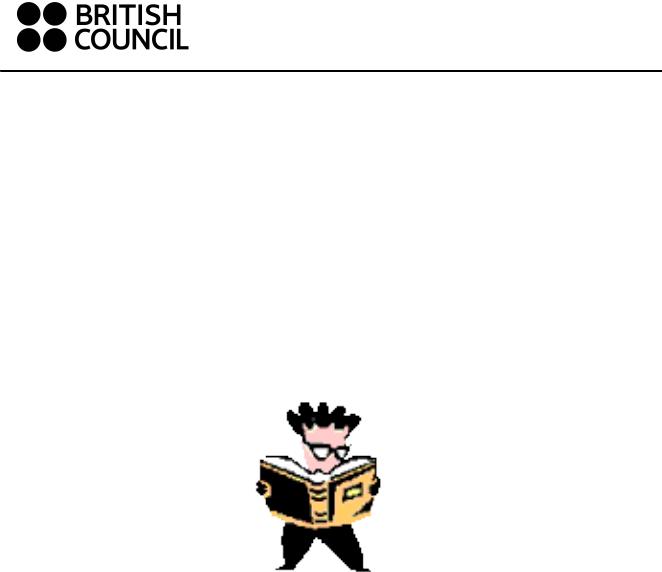
Language Arts
Professional Development for Teachers
Learning English through Short Stories
Re-write your first draft ideas using fortunately, unfortunately, because and some of the words below:
Today |
Suddenly |
Luckily |
|
Later that morning |
Later that day |
Finally |
|
Give your story an interesting beginning and end. Organise your ideas into paragraphs. Now tell your partner the story. Use your notes to help you but do not read from the paperkeep eye contact with your audience!
21
© The British Council
The United Kingdom’s international organisation for educational opportunities and cultural relations. We are registered in England as a charity.

Language Arts
Professional Development for Teachers
Learning English through Short Stories
Part 3 Introductory note to Learning & Teaching Activities
At this stage you will experience the activities from the perspective of the student. As we have limited time in the workshop, we will divide you into 6 groups, and give you instructions to follow in each group. The tutor will be mingling amongst you to help with procedures, ideas and the development of your work. Some of the work you generate at this point will be used as material for formative assessment practice in Part 4 of the day.
Important note: if you were to run these activities with your students, you would not give them the instructions to follow (remember that we have used this method in the workshop today because of time constraints). Instead, as a teacher, you would lead the students, stage by stage, through the activities.
Therefore, as you are working through the activities, think about the sequencing of your presentational language, your concept checking questions, your instructions and your roundup questions. This will help you decide which stages may need to be modified for the needs of your particular groups.
By the end of Part 3a, you will have:
∙experienced detailed procedures and worked with material which relates to each content part of the module and can be used, modified or adapted for
the needs of your own students.
22
© The British Council
The United Kingdom’s international organisation for educational opportunities and cultural relations. We are registered in England as a charity.
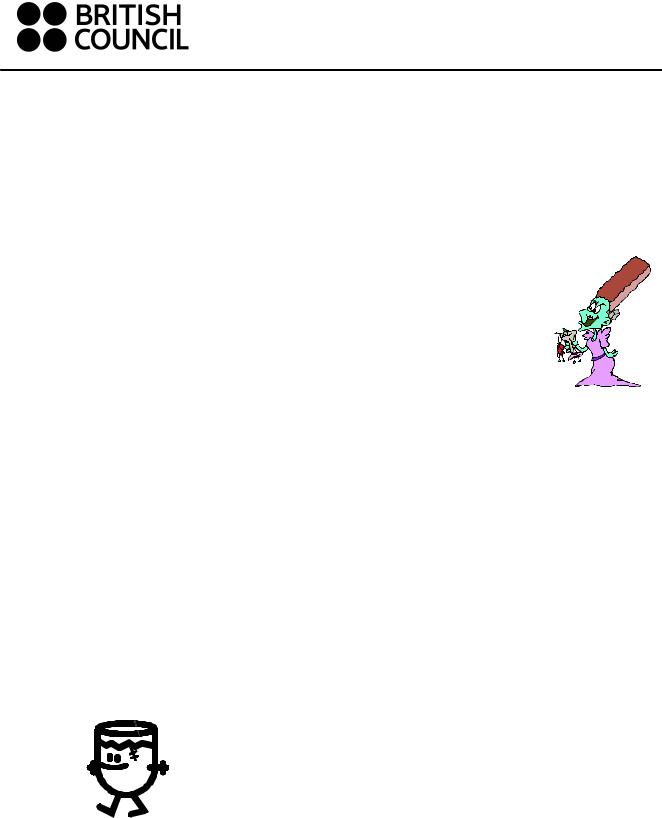
Language Arts
Professional Development for Teachers
Learning English through Short Stories
Activity 1 Characterisation: “FRANKENSTEIN” by Mary Shelley
Note for teachers: Strictly speaking, Frankenstein is not a short story, but these activities use the abridged version (from Oxford graded readers for language learners) which makes it accessible for students. We feel that it will be highly motivating for students to feel they can read an entire novel which is also a well-known classic.
A A SHORT DISCUSSION - BEFORE READING
Discuss the following questions with the students in your group.
∙ What is a monster?
∙What famous monsters can you think of?
∙Can you describe any monsters from films? Think about their appearance, behaviour and personality.
∙How might people react to a monster?
∙Do you think we’ll be able to create monsters in the future?
∙Read the following definitions of monsters and tick the ones you agree with:
A monster is someone who looks different a freak of nature
a scary creature a beautiful person
someone with a frightening appearance
a person or animal that is deformed or unusual
an imaginary creature having human and animal parts an extremely clever animal
a very cruel or wicked person a huge or horrible creature
Now look at the blurb on the back cover and read the first page of the book inside the front cover.
Tell your partner what you know about this story.
23
© The British Council
The United Kingdom’s international organisation for educational opportunities and cultural relations. We are registered in England as a charity.
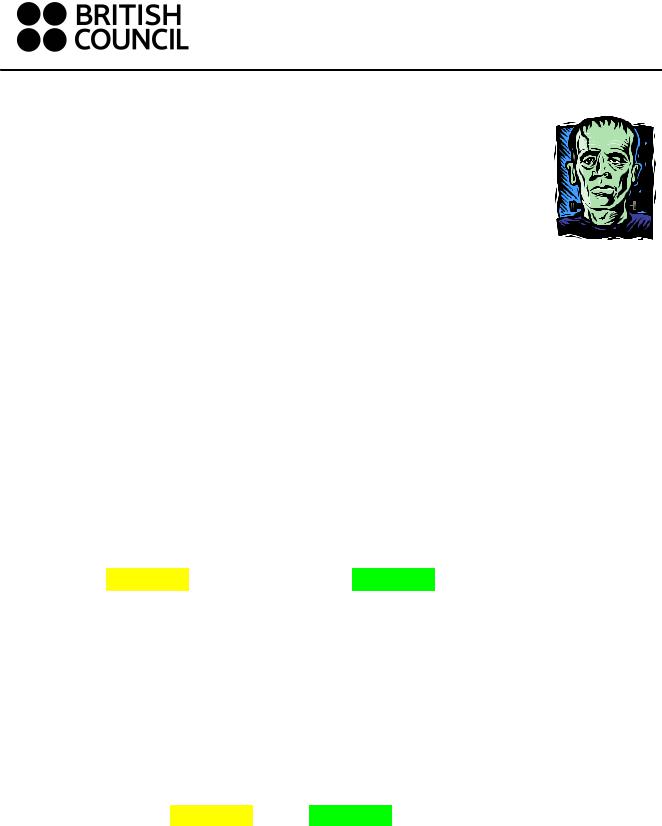
Language Arts
Professional Development for Teachers
Learning English through Short Stories
INSTRUCTIONS
1 Do activity 1 with your group.
2 Open Envelope 2 which contains:
- 6 copies of Student A and Student B Worksheet
∙Divide your group into 2 or 3 x Student As and 2 or 3 x Student Bs. Turn to the appropriate side of the worksheet (A or B).
∙Go to the chapter on your worksheet for the story “Frankenstein” by Mary Shelley and answer the questions.
You have 10-15 minutes to do this activity.
∙Now compare your ideas with someone who answered the same questions as you.
2Open Envelope 3 which contains 6 sheets.
∙You now need to work with someone who looked for information about a different character.
∙Each Student A should work with a Student B.
∙Tell your partner about your character using your notes to help you.
You have 10 minutes to do this part of the activity.
3Work together to complete the text analysis activities or sample extension task. Check with the answer key in Envelope 4.
You have 10 minutes to do this part of the activity.
4Open Envelope 5 which contains 6 A4 sheets. In your pairs (each pair should have a Student A and a Student B), discuss the questions and statements.
You have 15-20 minutes to do this activity.
24
© The British Council
The United Kingdom’s international organisation for educational opportunities and cultural relations. We are registered in England as a charity.

Language Arts
Professional Development for Teachers
Learning English through Short Stories
Envelope 2
BWHILE-READING TASK “FRANKENSTEIN” by Mary Shelley
STUDENT A: Victor Frankenstein’s story
1. What information can you find in the story about the character of Victor Frankenstein?
Fill in the table below with as much information as possible. Read Chapter 2 and chapter 3 to the end of page 7
Name: Victor Frankenstein : |
|
a. Where is he from? |
|
b. What do we know about his |
No specific details given. |
appearance? |
|
c.Tell us about his family
d.What do we know about his childhood?
e.What were his feelings about studying and learning?
f.How would you describe his personality? Tick the words which you think apply to him….
hard-working sensitive stupid focussed crazy kind light-hearted sad ambitious hopeless confused angry shy loving eccentric |
Justify your impression with examples from the story.
make some notes about the words you have chosen:
hard-working - studied hard at school, read a lot of books and wanted to learn
Fast finishers:
Write a short summary of Victor Frankenstein: I think he’s …………………………… because
…………………………………………………………………………………………………………..
……………………………………………………………………………………….........................
Exchange your ideas:
Work with a partner who read about the other character. Tell each other your information and fill in the other side of the worksheet as you talk with your partner.
25
© The British Council
The United Kingdom’s international organisation for educational opportunities and cultural relations. We are registered in England as a charity.
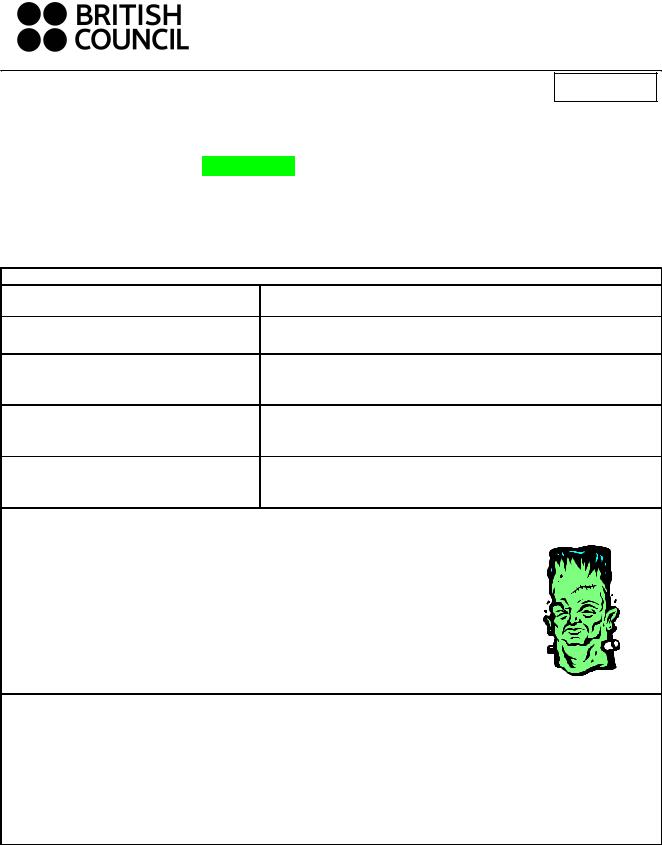
Language Arts
Professional Development for Teachers
Learning English through Short Stories
Envelope 2
BWHILE-READING TASK “FRANKENSTEIN” by Mary Shelley
STUDENT B: The Monster’s story
1. What information can you find in the story about the character of the monster?
Fill in the table below with as much information as possible. Read chapter 7.
Name: unknown |
|
a. Where is he from? |
Switzerland |
|
b.What do we know about his appearance?
c.How do people react to the monster?
d.How does he survive?
e.What did he learn from the blind family?
f.How would you describe his personality? Tick the words which you think apply to him….
hard-working sensitive stupid afraid crazy kind light-hearted sad ambitious hopeless confused angry shy loving eccentric |
Justify your impression with examples from the story.
make some notes about the words you have chosen: confused – he doesn’t understand the reaction of people to him
Fast finishers:
Write a short summary of the monster : I think he’s …………………………… because
…………………………………………………………………………………………………………..
……………………………………………………………………………………….......................
Exchange your ideas:
Work with a partner who read about the other character. Tell each other your information and fill in the other side of the worksheet as you talk with your partner.
26
© The British Council
The United Kingdom’s international organisation for educational opportunities and cultural relations. We are registered in England as a charity.
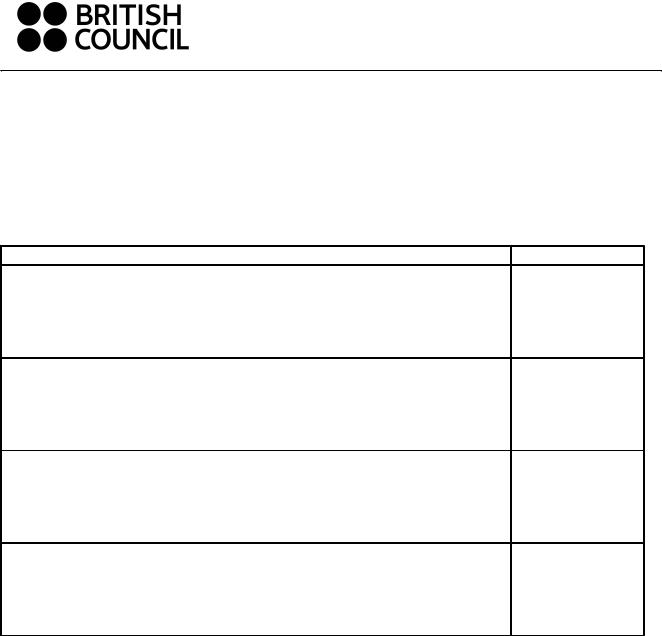
Language Arts
Professional Development for Teachers
Learning English through Short Stories
CPOST-READING TASKS
TEXT ANALYSIS
1. Look back at the chapters you read. Which of these short story devices does the write use to tell us about the character? Add an example from the text to illustrate your analysis.
How to show character in a story |
√ Х |
She uses some adjectives to describe their personalities, example: Victor was a hard-working and determined man. example:
She uses verbs and descriptions of actions/events to give us an impression of their personalities and how they behave. example:
She uses direct quotations from the characters to show how they speak.
example:
She shows how other people react to the characters. example:
2. Compare the following pairs of sentences. Choose the one in each pair which you think is more interesting for the reader and say why.
a)(i) The monster was very ugly and had big hands.
(ii)Their faces were filled with horror and fear when they saw him.
b)(i) He was a kind creature.
(ii)“I tried to help them in other ways too…”
c)(i) Victor was an ambitious man.
(ii)“I wanted to use electricity to help people, and I wanted to discover the secrets of life.”
27
© The British Council
The United Kingdom’s international organisation for educational opportunities and cultural relations. We are registered in England as a charity.

Language Arts
Professional Development for Teachers
Learning English through Short Stories
3. Sample Extension Task:
Read the extract below. Do you know when it takes place?
What is missing? (a) verbs |
(b) linking words |
(c) time reference words |
(1)__________ I had worked to make this creature but (2) _____ it looked terrible and frightening. I almost decided to destroy it. But I could not. I had to know if I could put life into it.
(3)_____________ I saw dark clouds in the sky, and I knew that a storm was coming.
(4)_______________________________ the lightning came. My mast began to do its work immediately and the electricity from the lightning travelled down the mast to my machine. Would the machine work?
(5)____________ nothing happened. But (6) _______________ I saw the creature’s body begin to move. Slowly, terribly, the body came alive. Its arms and legs began to move, and slowly it sat up.
The dead body had been an ugly thing, but alive, it was much more horrible.
(7)____________ I wanted to escape from it. I ran out of the laboratory, and locked the door. I was
filled with fear at what I had done.
(8) ____________, I walked up and down in my flat. (9) ___________ I lay down on my bed
and fell asleep.
Add the missing words and phrases to the gaps so that it is easier to understand when the events happen.
a) two days later |
f) after a few minutes |
b) for hours |
g) at about one o’clock in the morning |
c) at last |
h) now |
d) suddenly |
i) for a year |
e) at first |
|
28
© The British Council
The United Kingdom’s international organisation for educational opportunities and cultural relations. We are registered in England as a charity.

Language Arts
Professional Development for Teachers
Learning English through Short Stories
ANSWER KEY
POST-READING TASKS
TEXT ANALYSIS
1. Look back at the chapters you read. Which of these short story devices does the write use to tell us about the character? Add an example from the text to illustrate your analysis.
How to show character in a story |
√ |
Х |
She uses some adjectives to describe their personalities, |
|
|
example: Victor was a hard-working and determined man. |
|
√ |
example: |
|
|
|
|
|
She uses verbs and descriptions of actions/events to give us an |
|
|
impression of their personalities and how they behave. |
|
√ |
example: |
|
|
|
|
|
She uses direct quotations from the characters to show how they |
|
|
speak. |
|
|
example: |
|
Х |
She shows how other people react to the characters. |
|
|
example: |
|
√ |
|
|
2. Compare the following pairs of sentences. Choose the one in each pair which you think is more interesting for the reader and say why.
a)(i) The monster was very ugly and had big hands.
(ii)Their faces were filled with horror and fear when they saw him.
b)(i) He was a kind creature.
(ii)“I tried to help them in other ways too…”
c)(i) Victor was an ambitious man.
(ii)“I wanted to use electricity to help people, and I wanted to discover the secrets of life.”
Students’ own answers, but in general the second sentence in each pair is preferable because it makes use of the techniques in (1) above.

Language Arts
Professional Development for Teachers
Learning English through Short Stories
3. Sample Extension Task:
Read the extract below. Do you know when it takes place?
What is missing? (a) verbs |
(b) linking words (c) time reference words |
(1)_____ i ___ I had worked to make this creature but (2) __h _ it looked terrible and frightening. I almost decided to destroy it. But I could not. I had to know if I could put life into it.
(3)_____ a ______ I saw dark clouds in the sky, and I knew that a storm was coming.
(4)_____________ g ________________ the lightning came. My mast began to do its work immediately and the electricity from the lightning travelled down the mast to my machine. Would the machine work?
(5)_____ e _____ nothing happened. But (6) _______ f ______ I saw the creature’s body begin to move. Slowly, terribly, the body came alive. Its arms and legs began to move, and slowly it sat up.
The dead body had been an ugly thing, but alive, it was much more horrible.
(7)____ d ______ I wanted to escape from it. I ran out of the laboratory, and locked the door. I was
filled with fear at what I had done.
(8) ______ b ____, I walked up and down in my flat. (9) _____c _____ I lay down on my bed
and fell asleep.
Add the missing words and phrases to the gaps so that it is easier to understand when the events happen.
a)two days later
b)for hours
c)at last
d)suddenly
e)at first
f)after a few minutes
g)at about one o’clock in the morning
h)now
i)for a year
30
© The British Council
The United Kingdom’s international organisation for educational opportunities and cultural relations. We are registered in England as a charity.
